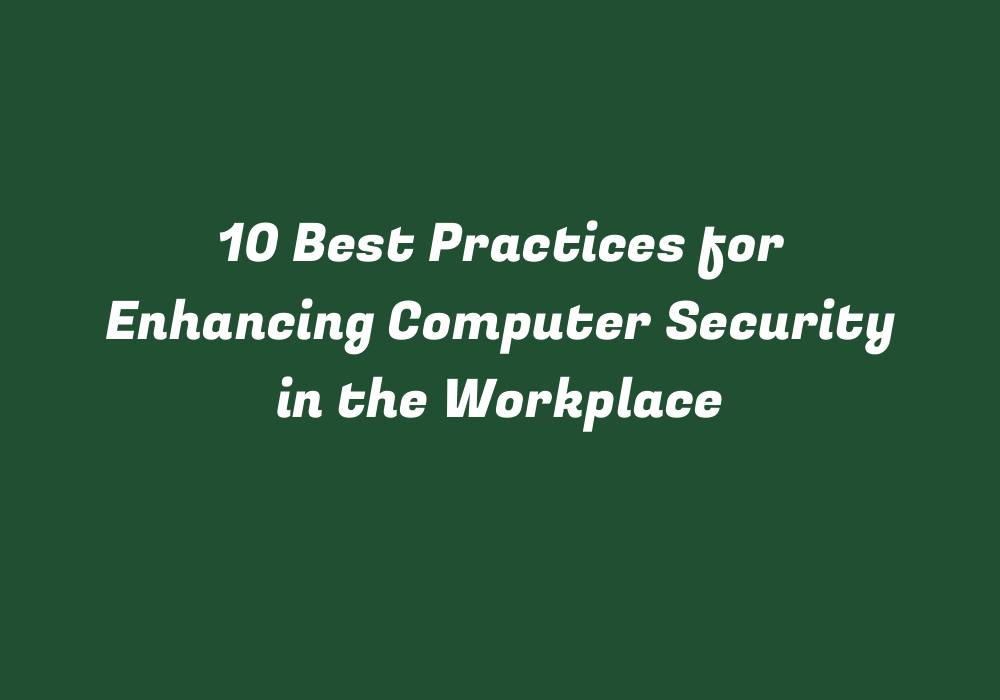Introduction: Importance of Enhancing Computer Security in the Workplace
In today’s digital age, businesses rely heavily on computers and the internet for various tasks such as communication, data storage, and day-to-day operations. However, cyber threats and malicious attacks are constantly evolving, making it crucial to implement robust computer security practices in the workplace to safeguard sensitive information and prevent data breaches. Here are 10 best practices that can help enhance your organization’s computer security.
1. Create a Strong Password Policy
A password policy is one of the essential practices for maintaining computer security in the workplace. It sets guidelines for the creation, use, and protection of passwords to ensure their effectiveness in preventing unauthorized access. Key elements of a strong password policy include:
a. Require minimum length (ideally at least 10 characters).
b. Use a mix of uppercase, lowercase, numbers, special characters.
c. Prohibit commonly used words and phrases.
d. Periodically enforce password changes (e.g., every 90 days).
e. Limit the number of login attempts to prevent brute-force attacks.
f. Restrict sharing or disclosure of passwords.
2. Implement Two-Factor Authentication
Two-factor authentication (2FA) is a security process that requires users to provide two forms of identification before gaining access to an account. This adds an extra layer of protection against hackers and data breaches, as even if one form of authentication is compromised, the other still needs to be successfully bypassed to gain unauthorized access. Consider implementing 2FA for critical systems and services like email, financial platforms, or cloud storage accounts.
3. Regularly Update and Patch Software
Software updates and patches often include security fixes that address vulnerabilities discovered in the system. By neglecting to install them promptly, organizations leave themselves exposed to potential threats, such as malware attacks or data breaches. To minimize risk, ensure that all computers and devices are configured to automatically update software and apply relevant patches without delay.
4. Utilize Firewalls and Antivirus Software
Firewalls serve as a protective barrier between an internal network and external connections, preventing unauthorized access from malicious sources. Similarly, antivirus software is crucial for identifying, neutralizing, and removing viruses, spyware, ransomware, and other malicious code before they can cause significant damage to the system. Make sure that all workstations are equipped with reliable firewall and antivirus solutions, regularly updated to stay effective against emerging threats.
5. Back Up Data Periodically
Data backup is vital for ensuring business continuity in case of a catastrophic event such as a cyber attack or hardware failure. Maintain regular off-site backups, keeping multiple copies to minimize the risk of data loss and to facilitate easy restoration. Consider implementing automated data backup systems for seamless management and maximum reliability.
6. Educate Employees on Cybersecurity Awareness
Human error plays a significant role in cybersecurity incidents, including phishing attacks, malware infections, and other vulnerabilities that could compromise the organization’s information systems. Therefore, it is essential to educate employees about best practices for secure online behavior, such as avoiding suspicious emails or websites, exercising caution when accessing sensitive data, and understanding the importance of strong passwords.
7. Implement Access Control Measures
Access control measures enable organizations to grant or restrict users’ permissions based on their job roles and responsibilities. By limiting user privileges to only those required for their tasks, you reduce the risk of accidental data leaks or intentional misuse. Establish clear guidelines on which employees have access to specific information systems and implement appropriate tools (e.g., role-based access control) to enforce these policies effectively.
8. Encrypt Sensitive Data
Encryption is the process of scrambling data to make it unreadable without the proper decoding key. By encrypting sensitive information, such as financial records or confidential communications, organizations can reduce the risk of data breaches and maintain privacy even if it falls into the wrong hands. Ensure that all critical data is protected by implementing encryption methods, whether at-rest (e.g., stored data) or in-transit (e.g., during transmission).
9. Monitor Network Activity
Monitoring network activity helps detect and prevent potential threats before they cause damage to your organization’s information systems. By continuously tracking user behavior, access attempts, and suspicious activities on the network, you can identify anomalies or unauthorized access attempts more quickly. Implement security monitoring tools, such as intrusion detection systems (IDS) or security incident and event management (SIEM), to analyze and alert your IT team when necessary.
10. Regularly Assess and Update Security Measures
To maintain an effective computer security posture in the workplace, it is vital to regularly review existing policies and procedures and update them as needed to stay ahead of evolving threats. Schedule periodic audits or penetration tests to identify potential vulnerabilities and adjust your cybersecurity strategy accordingly. This proactive approach ensures that you remain vigilant and resilient against the ever-changing landscape of cyberattacks.
In conclusion, implementing these best practices for enhancing computer security in the workplace plays a crucial role in protecting valuable data and maintaining business continuity. By fostering a culture of security awareness, leveraging appropriate technology solutions, and continuously evaluating your organization’s risk profile, you can significantly reduce the likelihood of falling victim to cyber threats or experiencing devastating data breaches.
